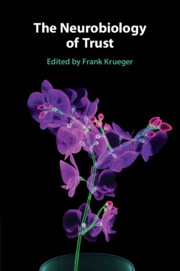Book contents
- The Neurobiology of Trust
- The Neurobiology of Trust
- Copyright page
- Dedication
- Contents
- Figures
- Tables
- Contributors
- Abbreviations
- Introduction
- Part I Fundamental Level of Trust
- Part II Neuropsychological Level of Trust
- Part III Neurocharacteristic Level of Trust
- Chapter 9 Trust and Distrust
- Chapter 10 Trust and Reciprocity
- Chapter 11 Trust and Demographics
- Chapter 12 Trust and Brain Dynamics
- Part IV Neuromolecular Level of Trust
- Part V Neuropathological Level of Trust
- Index
- References
Chapter 10 - Trust and Reciprocity
The Role of Outcome-Based and Belief-Based Motivations
from Part III - Neurocharacteristic Level of Trust
Published online by Cambridge University Press: 09 December 2021
- The Neurobiology of Trust
- The Neurobiology of Trust
- Copyright page
- Dedication
- Contents
- Figures
- Tables
- Contributors
- Abbreviations
- Introduction
- Part I Fundamental Level of Trust
- Part II Neuropsychological Level of Trust
- Part III Neurocharacteristic Level of Trust
- Chapter 9 Trust and Distrust
- Chapter 10 Trust and Reciprocity
- Chapter 11 Trust and Demographics
- Chapter 12 Trust and Brain Dynamics
- Part IV Neuromolecular Level of Trust
- Part V Neuropathological Level of Trust
- Index
- References
Summary
Trust and reciprocity are two closely linked concepts that are ubiquitous within cooperative exchange. To distinguish the two, we first review potential motivations that drive trusting and reciprocal behavior. Economic theories suggest that both preferences over monetary distributions (outcome-based) as well as considerations about others’ intentions (belief-based) may contribute to decisions to trust and reciprocate. Outcome-based theories suggest that individuals’ internal preferences over monetary distribution influence decision-making. In comparison, belief-based theories assume that individuals’ expectations about themselves and others generate emotions that influence decision-making. Turning to the neuroscience of trust and reciprocity with the trust game, we find that neural activations in insula, dorsolateral prefrontal cortex, and anterior cingulate cortex are common to belief-based motivations, while neural responses in caudate and amygdala reflect outcome-based motivations. Integrating economic theory with neuroscientific findings, we suggest that reciprocal behavior is primarily driven by belief-based motivations while trust behavior is associated with outcome-based preferences. We propose that future research should examine the potential context-dependent nature of behavioral motivations, investigate both positive and negative reciprocity, and leverage the trust game and related paradigms to parse potential sources of social dysfunction in mental illness.
- Type
- Chapter
- Information
- The Neurobiology of Trust , pp. 236 - 268Publisher: Cambridge University PressPrint publication year: 2021



